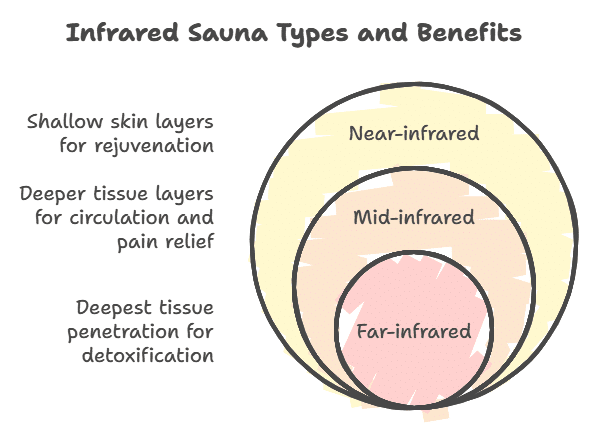Infrared Sauna and Exercise: The Ultimate Recovery Boost
Infrared saunas have gained significant popularity in recent years, especially among athletes and fitness enthusiasts looking to enhance their recovery and performance. But what exactly makes infrared saunas so beneficial, and how can they complement your exercise routine? In this article, we’ll dive into the science behind infrared saunas, explore their unique advantages for muscle recovery and athletic performance, and provide practical tips on how infrared sauna and exercise best fit together.
What is an Infrared Sauna?
Before we explore how infrared saunas can benefit your workouts, it’s important to understand what sets them apart from traditional saunas.
How Infrared Saunas Work
Unlike traditional saunas that rely on heating the air around you, infrared saunas use infrared light to penetrate directly into your body. This allows for deeper heat penetration at lower temperatures, typically between 110°F and 140°F. As a result, you can experience the benefits of heat therapy without the discomfort of sitting in extremely high temperatures.
Types of Infrared Saunas

Infrared saunas come in three types based on the wavelength of light they emit:
- Near-infrared: Penetrates the shallowest layer of skin and is often used for skin rejuvenation.
- Mid-infrared: Reaches deeper tissue layers and is beneficial for improving circulation and relieving pain.
- Far-infrared: Penetrates the deepest layers of tissue and is most effective for detoxification and muscle recovery.
Key Benefits:
- Deeper Heat Penetration: Infrared light reaches deeper into muscles than traditional heat, making it more effective for recovery.
- Lower Temperatures: The lower heat makes it easier to stay in longer sessions without feeling overwhelmed by extreme temperatures.
How Infrared Saunas Aid in Exercise Recovery
One of the main reasons athletes turn to infrared saunas is their ability to accelerate post-workout recovery. Let’s break down how they help:
Enhanced Muscle Recovery
After a tough workout, your muscles are often sore due to microtears that occur during exercise. This soreness, known as delayed onset muscle soreness (DOMS), can last for several days. Infrared saunas help reduce DOMS by increasing blood flow to the muscles, which speeds up the delivery of oxygen and nutrients necessary for repair. Additionally, the heat helps relax tight muscles and reduce lactic acid buildup, which is a common cause of post-exercise fatigue.
Improved Blood Circulation
Infrared heat promotes vasodilation (the widening of blood vessels), which enhances blood flow throughout your body. This improved circulation helps deliver oxygen-rich blood to tired muscles faster, aiding in quicker recovery. Better circulation also helps flush out metabolic waste products like lactic acid that accumulate after intense exercise, reducing inflammation and muscle soreness.
Joint Pain Relief
Joint pain is a common concern for those who engage in high-impact sports or heavy lifting. Infrared saunas can help alleviate joint stiffness by increasing flexibility and reducing inflammation around joints. This makes them an excellent tool for athletes and individuals suffering from arthritis or chronic joint pain.
Boosting Athletic Performance with Infrared Saunas

In addition to aiding recovery, regular use of an infrared sauna can enhance overall athletic performance over time.
Increased Endurance
Studies suggest regular sauna use can improve cardiovascular health by increasing heart rate and oxygen efficiency. When your heart works harder during a sauna session, it mimics the effects of moderate exercise on your cardiovascular system. Over time, this can improve endurance during workouts or athletic competitions. Athletes who incorporate infrared sauna sessions into their routine often report longer stamina and quicker recovery between training sessions.
Heat Tolerance
Training in high temperatures can be challenging for many athletes. However, regular use of an infrared sauna helps your body adapt to heat stress by improving its ability to regulate temperature efficiently. This increased heat tolerance can benefit athletes who train outdoors or compete in warmer climates. With better heat adaptation, you’ll be able to push through tough workouts without overheating as easily.
Mental Resilience
The benefits of infrared saunas extend beyond physical performance—they also positively impact mental well-being. The calming effects of infrared heat help reduce stress levels and promote relaxation. This anxiety reduction can lead to better focus and improved performance for athletes who need mental clarity during competition or high-pressure training sessions.
Timing Your Infrared Sauna Sessions Around Workouts
Using an infrared sauna is as important as how often you use it. Here’s how to time your sessions for maximum benefit:
Pre-Workout Benefits
A short session before exercising can help warm up your muscles and increase flexibility, reducing the risk of injury during intense workouts. The gentle heat from an infrared sauna increases blood flow to your muscles, making them more pliable and ready for action.
However, staying hydrated is crucial if you’re using a sauna before working out since sweating can lead to fluid loss even before you start exercising.
Pre-Workout Tips:
- Limit pre-workout sauna sessions to 10-15 minutes.
- Keep the temperature moderate (around 110°F).
- Drink plenty of water before entering the sauna.
Post-Workout Recovery Routine
Most athletes prefer using an infrared sauna after workouts as part of their recovery routine. A 20-minute session at moderate temperatures (around 120°F) is ideal for relaxing sore muscles and speeding up recovery without causing dehydration.
Post-Workout Tips:
- Wait 15-30 minutes after exercising before entering the sauna.
- Keep sessions under 30 minutes.
- Rehydrate immediately after your session with water or electrolyte-rich drinks.
Avoiding Overuse
While infrared saunas offer great benefits, overusing them—especially after intense exercise—can lead to dehydration or overheating. It’s important to listen to your body’s signals and limit sessions if you feel dizzy or overly fatigued.
Safety Tips for Using Infrared Saunas
While generally safe for most people, there are some precautions you should take when using an infrared sauna:
Hydration is Key
Because you lose fluids through sweat during sauna sessions, staying hydrated before, during, and after each session is essential. If not properly managed, dehydration can lead to dizziness or fainting.
Start Slow
If you’re new to infrared saunas or haven’t used one, start with shorter sessions (10–15 minutes) at lower temperatures until your body gets used to the heat.
Listen to Your Body
While regular sauna use has many benefits, it’s crucial not to overdo it. If you feel lightheaded or overly fatigued during a session, exit immediately and rest until you feel better.
Consult a Doctor
If you have any preexisting conditions like heart disease or low blood pressure—or if you’re pregnant—it’s always wise to consult with a healthcare provider before incorporating regular sauna use into your routine.
Success Stories: Athletes Who Swear by Infrared Saunas
Many professional athletes have incorporated infrared saunas into their training routines with great success:
- LeBron James, one of basketball’s most famous stars, regularly uses infrared saunas as part of his post-game recovery routine.
- Tom Brady, NFL quarterback legend, also includes infrared sauna therapy in his wellness regimen. He believes it helps him recover faster between games and maintain peak performance even at an older age.
These success stories highlight how top-tier athletes use this technology for relaxation and as a vital component of their overall fitness strategy.
Why You Should Incorporate Infrared Saunas Into Your Routine?
Incorporating infrared sauna sessions into your fitness routine offers numerous benefits—from faster recovery after workouts to enhanced athletic performance. These saunas provide a holistic approach that complements any workout regimen by helping your body recover more efficiently while boosting endurance and mental resilience.
Ready to take your fitness routine up a notch? Try incorporating an infrared sauna session post-workout for enhanced recovery and improved performance!
FAQ
Q: Can I use an infrared sauna every day?
A: While some people may tolerate daily use well, most experts recommend using an infrared sauna 3–4 times weekly for optimal results without overexerting the body.
Q: Is it safe to use an infrared sauna before working out?
A: Yes! A short session before exercise can help warm up your muscles and increase flexibility. Ensure you stay hydrated throughout the process.
Q: How long should I stay in an infrared sauna after exercising?
A: A 20-minute session at moderate temperatures (around 120°F) is ideal for post-workout recovery without causing dehydration or overheating risks.
Q: What are the main differences between traditional saunas and infrared saunas?
A: Traditional saunas heat the air around you, while infrared saunas use light waves that penetrate directly into tissues at lower temperatures—making them more comfortable yet equally effective


